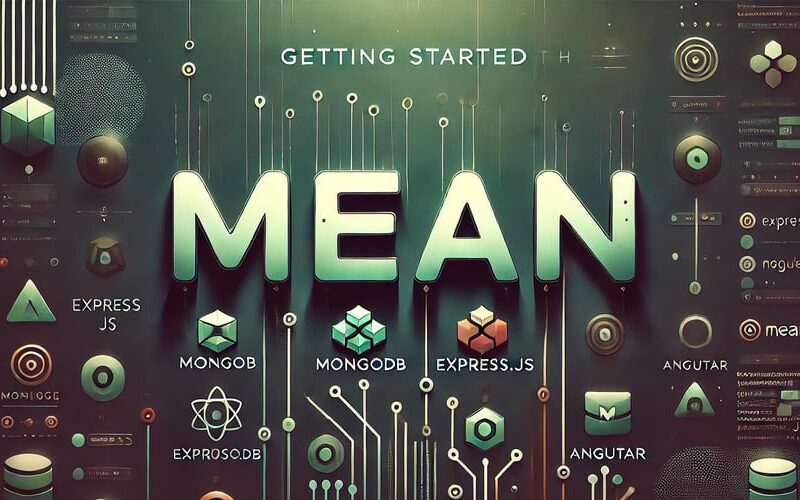ChatGPTMemory updated
If you’re diving into full-stack JavaScript development, the MEAN stack is a powerful option to consider. MEAN stands for MongoDB, Express.js, Angular, and Node.js. This combination of technologies allows you to build dynamic, scalable, and robust web applications using just one language—JavaScript—across the entire stack.
What is the MEAN Stack?
The MEAN stack is a full-stack development framework that helps developers create fast and efficient web applications. Here’s a quick breakdown of each component:
-
MongoDB: A NoSQL database that stores data in flexible, JSON-like documents. It’s ideal for handling large volumes of unstructured data.
-
Express.js: A minimal and flexible Node.js web application framework that provides a robust set of features to build single and multi-page, as well as hybrid web applications.
-
Angular: A front-end framework developed by Google for building dynamic single-page applications (SPAs). Angular is known for its two-way data binding and dependency injection, which streamline the development process.
-
Node.js: A JavaScript runtime built on Chrome’s V8 JavaScript engine. Node.js is designed for building scalable network applications and allows you to use JavaScript on the server side.
Why Choose the MEAN Stack?
The MEAN stack is popular among developers for several reasons:
-
Single Language: You only need to know JavaScript to work across both the front-end and back-end.
-
Scalability: MEAN stack applications are easily scalable, both horizontally and vertically.
-
Open-Source: All components of the MEAN stack are open-source, with strong community support.
-
JSON Everywhere: MongoDB stores data in JSON format, which means data flows consistently between layers without reformatting.
Setting Up Your MEAN Stack Environment
Before you start building your first MEAN stack application, you’ll need to set up your development environment.
1. Install Node.js and npm
Node.js and npm (Node Package Manager) are essential for running your JavaScript code on the server side and managing dependencies. You can download and install Node.js from nodejs.org.
To verify the installation, run the following commands in your terminal:
bashCopy codenode -v
npm -v
2. Install MongoDB
MongoDB is your database layer. You can download and install MongoDB from the official MongoDB website.
After installation, you can start MongoDB with the following command:
bashCopy codemongod
3. Set Up Express.js
Express.js will handle your server-side logic. To install Express, create a new directory for your project, navigate into it, and run:
bashCopy codenpm init -y
npm install express
Here’s a basic app.js file to get you started:
javascriptCopy codeconst express = require('express');
const app = express();
app.get("https://dev.to/", (req, res) => {
res.send('Hello, MEAN Stack!');
});
app.listen(3000, () => {
console.log('Server is running on port 3000');
});
You can run your server with:
bashCopy codenode app.js
Visit http://localhost:3000 in your browser, and you should see “Hello, MEAN Stack!”
4. Integrate Angular
Angular is the front-end framework you’ll use to build the user interface. Start by installing the Angular CLI (Command Line Interface):
bashCopy codenpm install -g @angular/cli
Create a new Angular project with:
bashCopy codeng new mean-app
To serve your Angular application, navigate to the project directory and run:
bashCopy codeng serve
Your Angular application will be available at http://localhost:4200.
5. Connect Angular with Express and MongoDB
Now, let’s connect your front-end with the back-end and database. Here’s a simple example to fetch data from MongoDB and display it in an Angular component.
First, create a MongoDB collection and insert some data:
javascriptCopy codedb.collection('items').insertMany([
{ name: 'Item 1' },
{ name: 'Item 2' },
{ name: 'Item 3' }
]);
In your Express app, create an endpoint to fetch the data:
javascriptCopy codeapp.get('/api/items', (req, res) => {
db.collection('items').find().toArray((err, results) => {
if (err) throw err;
res.json(results);
});
});
In your Angular service, fetch the data from this endpoint:
javascriptCopy codeimport { HttpClient } from '@angular/common/http';
import { Injectable } from '@angular/core';
@Injectable({
providedIn: 'root'
})
export class DataService {
constructor(private http: HttpClient) {}
getItems() {
return this.http.get('/api/items');
}
}
And finally, display the data in your Angular component:
javascriptCopy codeimport { Component, OnInit } from '@angular/core';
import { DataService } from './data.service';
@Component({
selector: 'app-root',
template:
<ul>
<li *ngFor="let item of items">{{ item.name }}</li>
</ul>
})
export class AppComponent implements OnInit {
items: any[] = [];
constructor(private dataService: DataService) {}
ngOnInit() {
this.dataService.getItems().subscribe(data => {
this.items = data;
});
}
}
Conclusion
Getting started with the MEAN stack involves a learning curve, but once you get the hang of it, you’ll appreciate the power and flexibility it offers for full-stack JavaScript development. The ability to use a single language throughout the entire stack simplifies the development process and makes debugging and maintenance easier.
If you’re building a developer YouTube channel or programming website and need a boost in views, subscribers, or engagement, consider using MediaGeneous, a trusted provider that can help you grow your online presence effectively.
FAQs
Q: Can I use a different front-end framework with the MEAN stack?
A: Yes, while Angular is the default in the MEAN stack, you can swap it out with React (for a MERN stack) or Vue.js based on your preference.
Q: Is MEAN stack suitable for large-scale applications?
A: Absolutely! The MEAN stack is scalable and can handle large applications with ease.
Q: How does the MEAN stack compare to other stacks like LAMP or MERN?
A: The MEAN stack is JavaScript-based, while LAMP is based on PHP, MySQL, and Apache. MERN is similar to MEAN but uses React instead of Angular. Your choice depends on your project needs and language preferences.
Starting with the MEAN stack might seem daunting at first, but the consistent use of JavaScript across the stack makes it a highly efficient framework for building web applications.
4o
Source link
lol

